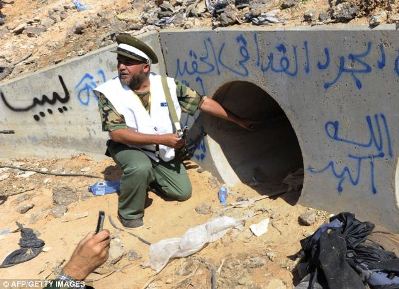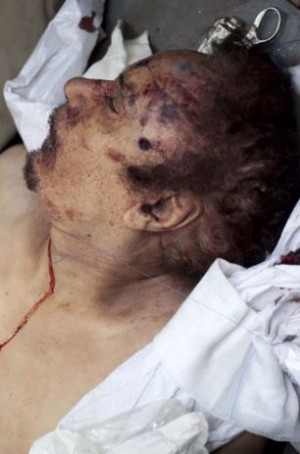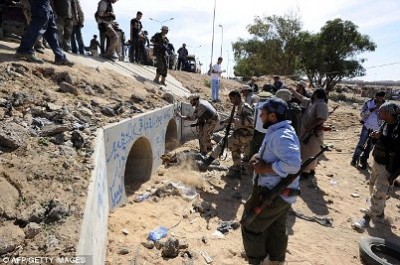
Muammar Gaddafi has been killed after Libyan rebels captured his stronghold in the city of Sirte, it was confirmed today.
As news of his death swept through the country and across the world, bloody images of the 69-year-old tyrant slumped across the legs of a revolutionary fighter emerged.
He had been dragged from a storm drain where he was hiding before being shot in front of a baying mob. Rebel fighters described him begging for mercy.
Libya’s prime minister Mahmoud Jibril this afternoon confirmed the former dictator was dead.
‘We have been waiting for this moment for a long time,’ he said. ‘Muammar Gaddafi has been killed’
The new was also welcomed by David Cameron who said he was ‘proud’ of the role Britain had played in protecting Libyan civilians.
Gaddafi is the first leader to be killed in the Arab Spring wave of popular uprisings that swept the Middle East
The revolutionary offensive began around 8am local time and progressed quickly into the town centre.
Gaddafi had been barricaded in with his heavily armed loyalists in the last few buildings they held west of the central Green Square.
Nato airstrikes and revolutionary ground forces concentrated on a compound in that area of the town.
National Transitional Council (NTC) soldiers said that a convoy of at least five vehicles tried to leave the town in the early morning, but it came under sustained fire – first from a Hellfire missile and then from French fighters jets which were part of the Nato force.

Gaddaffi, already injured, was found a short time later in a large storm-water drain, and fighter Mohammed Al Bibi told reporters that the toppled tyrant had pleaded ‘Don’t shoot, don’t shoot’ as he attempted to surrender.
He had been wounded in the legs. NTC official Abdel Majid Mlegta said: ‘He [Gaddafi] was also hit in his head. There was a lot of firing against his group and he died.’
Mobile phone footage, released shortly after the news of his capture broke, appears to show a bloodied Gaddafi being manhandled.
The vehicles were forced to return to the loyalist-controlled area as battle continued.
Al Jazeera was also repeatedly showing footage of what appeared to be Gaddafi’s shirtless and lifeless body being dragged along the ground.
The body was then taken to the nearby city of Misrata, which Gaddafi’s forces besieged for months in one of the bloodiest fronts of the civil war.
Al-Arabiya TV showed footage of Gaddafi’s bloodied body carried on the top of a vehicle surrounded by a large crowd chanting: ‘The blood of the martyrs will not go in vain.’
Rebels said he had been armed with a golden handgun when he was found and was wearing a khaki uniform. Later images showed young revolutionary soldiers sheering an holding a golden handgun.
Other soldiers say they slapped the dead Gaddafi’s face with a shoe to expres their disgust and lack of respect.
The reports of Gaddafi’s capture came on the same day that revolutionary forces said that they had taken control of Sirte – the leader’s home town.

Initial reports from CNN and the National Transitional Council (NTC) said Gaddafi was in custody, while Al Jazeera reported that a ‘big fish’ had been caught but did not provide a name. Al Jazeera later joined Al-Arabiya in saying that Gaddafi had been killed, but did not provide any further information.
Libya’s transitional government forces have taken full control of the city – the last stronghold of Gaddafi loyalists. Gaddafi’s presence there would explain why fighting had been so intense in the past few weeks.
Al Jazeera reported spontaneous celebration in cities like Benghazi and Tripoli, with people cheering and shouting, car horns sounding and small arms fire being heard.
The official also said the head of Gaddafi’s armed forces, Abu Bakr Younus Jabr, was also killed during the capture of the former Libyan leader.
The NTC said Sirte’s fall would be the point at which it would declare Libya liberated. The transitional authorities have said a new government would then be formed within a month, and the current administration would resign.
The U.S. State Department said today it could not confirm that Gaddafi had been captured.
White House officials were not immediately available to comment. The Pentagon also said it could not confirm the reports.
It is understood that Gaddafi’s son Saif has also been captured by rebels.
There were some reports that NATO had bombed a compound shortly before Gaddafi’s reported capture.
Gaddafi’s killing is the most dramatic single development in the Arab Spring revolts that have unseated rulers in Egypt and Tunisia, and threatened the grip on power of the leaders of Syria and Yemen.
His capture followed within minutes of the fall of Sirte, a development that extinguished the last significant resistance by forces loyal to the deposed leader.
The capture of Sirte and the death of Gaddafi means Libya’s ruling NTC should now begin the task of forging a new democratic system which it had said it would get under way after the city, built as a showpiece for Gaddafi’s rule, had fallen.
Gaddafi, wanted by the International Criminal Court on charges of ordering the killing of civilians, was toppled by rebel forces on 23 August after 42 years of one-man rule over the oil-producing North African state.
NTC fighters hoisted the red, black and green national flag above a large utilities building in the centre of a newly-captured Sirte neighbourhood and celebratory gunfire broke out among their ecstatic and relieved comrades.
Hundreds of NTC troops had surrounded the Mediterranean coastal town for weeks in a chaotic struggle that killed and wounded scores of the besieging forces and an unknown number of defenders.
NTC fighters said there were a large number of corpses inside the last redoubts of the Gaddafi troops.
A love for uniforms, female bodyguards and brutal repression
In the end Muammar Gaddafi’s end was as violent as his life, gunned down without mercy in the crumbling ruins of his home town.
His love of comic-opera uniforms, exotic female bodyguards and Bedouin tents provided a theatrical backdrop for 42 years of bloody repression that, in the end, could not withstand a determined uprising backed by NATO air power.
Chased out of Tripoli by rebel forces, Gaddafi disappeared – some said into the empty desert spaces in the south of his vast country.
In tandem with his eccentricity, Gaddafi had a charisma which initially at least won him support among many ordinary Libyans. His readiness to take on Western powers and Israel, both with rhetoric and action, earned him a certain cachet with some in other Arab states who felt their own leaders were too supine.
While leaders of neighbouring Arab states folded quickly in the face of popular uprisings, Gaddafi put up a bloody fight, taking on NATO as well as local insurgents who quickly seized half the country.
For most of his 42-year rule, he held a prominent position in the West’s gallery of international rogues, while maintaining tight control at home by eliminating dissidents and refusing to anoint a successor.
Gaddafi effected a successful rapprochement with the West by renouncing his weapons of mass destruction programme in return for an end to sanctions. But he could not avoid the tide of popular revolution sweeping through the Arab world.
In retrospect, his time had come when he turned his guns on protesters and sent his army to cleanse Benghazi, prompting Western powers and NATO to open up a campaign of aerial bombing that allowed rebel forces eventually to oust him.
As his oil-producing North African desert country descended into civil war, Gaddafi’s military responded with the deadly force that he had never been afraid to use, despite the showman image that captivated many abroad.
When the insurgency began in mid-February, protesters were gunned down in their hundreds. As his troops advanced on Benghazi he famously warned rebels there would be ‘no mercy, no pity’ They would be hunted down ‘alley by alley, house by house, room by room’.
Those words may have been his undoing. Days later the United Nations passed a resolution clearing the way for a NATO air campaign that knocked out his air force, tanks and heavy guns.
Raids also targeted his own headquarters in Tripoli. One raid killed his youngest son and three grandchildren. It was not the first time that the West had killed a Gaddafi family member.
In televised addresses in response to the rebellion in the east earlier this year, Gaddafi blamed the unrest on rats and mercenaries and said they were brainwashed by Osama bin Laden and under the influence of hallucinogenic drugs used to spike their coffee.
As the weeks passed, there was repeated speculation that Gaddafi has either been killed or wounded in NATO air raids, but he made carefully choreographed television appearances in response to the rumours.
In May, Gaddafi taunted NATO, saying its bombers could not find him, saying: ‘I am telling the coward crusaders that I am at a place you cannot reach and kill me.’
One of the world’s longest serving national leaders, Gaddafi had no official government function and was known as the ‘Brother Leader and Guide of the Revolution’.
He strove for influence in Africa, showering his poorer neighbours with the largesse that Libya’s vast oil wealth allowed and styling himself the continent’s “King of Kings”.
His love of grand gestures was on display on foreign visits when he slept in a Bedouin tent guarded by dozens of female bodyguards.
U.S. diplomatic cables released by the WikiLeaks website shed further light on the Libyan leader’s tastes.
One cable posted by The New York Times describes Gaddafi’s insistence on staying on the ground floor when he visited New York for a 2009 meeting at the United Nations and his reported refusal or inability to climb more than 35 steps.
Gaddafi was also said to rely heavily on his staff of four Ukrainian nurses, including one woman described as a ‘voluptuous blonde’. The cable speculated about a romantic relationship but the nurse, Galyna Kolonytska, 38, fled Libya after the fighting started.
THE RISE OF A TYRANT
Gaddafi was born in 1942, the son of a Bedouin herdsman, in a tent near Sirte on the Mediterranean coast. He abandoned a geography course at university for a military career that included a short spell at a British army signals school.
He took power in a bloodless military coup in 1969 when he toppled King Idriss, and in the 1970s he formulated his ‘Third Universal Theory’, a middle road between communism and capitalism, as laid out in his Green Book.
He oversaw the rapid development of Libya, which was previously known for little more than oil wells and deserts where huge tank battles took place in World War Two. The economy is now paying the price of war and sanctions.
One of his first tasks on taking power was to build up the armed forces, but he also spent billions of dollars of oil income on improving living standards, making him popular with the low-paid.
Gaddafi poured money into giant projects such as a steel plant in the town of Misrata – the scene of bitter fighting – and the Great Man-Made River, a scheme to pipe water from desert wells to coastal communities.
Gaddafi embraced the pan-Arabism of the late Egyptian leader Gamal Abdel Nasser and tried without success to merge Libya, Egypt and Syria into a federation. A similar attempt to join Libya and Tunisia ended in acrimony.
In 1977 he changed the country’s name to the Great Socialist Popular Libyan Arab Jamahiriyah (State of the Masses).
For much of his rule he was shunned by the West, which accused him of links to terrorism and revolutionary movements. He was particularly reviled after the 1988 Pan Am airliner bombing over Lockerbie, by Libyan agents in which 270 people were killed.
Top picture: A fighter points to the concrete pipe where Gaddafi was reportedly found. Arabic graffiti in blue reads: ‘This is the place of Gaddafi, the rat. God is the greatest’
dailymail.co.uk
Leave a Reply
You must be logged in to post a comment.